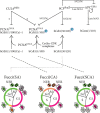Space Radiation Biology for "Living in Space"
- PMID: 32337251
- PMCID: PMC7168699
- DOI: 10.1155/2020/4703286
Space Radiation Biology for "Living in Space"
Abstract
Space travel has advanced significantly over the last six decades with astronauts spending up to 6 months at the International Space Station. Nonetheless, the living environment while in outer space is extremely challenging to astronauts. In particular, exposure to space radiation represents a serious potential long-term threat to the health of astronauts because the amount of radiation exposure accumulates during their time in space. Therefore, health risks associated with exposure to space radiation are an important topic in space travel, and characterizing space radiation in detail is essential for improving the safety of space missions. In the first part of this review, we provide an overview of the space radiation environment and briefly present current and future endeavors that monitor different space radiation environments. We then present research evaluating adverse biological effects caused by exposure to various space radiation environments and how these can be reduced. We especially consider the deleterious effects on cellular DNA and how cells activate DNA repair mechanisms. The latest technologies being developed, e.g., a fluorescent ubiquitination-based cell cycle indicator, to measure real-time cell cycle progression and DNA damage caused by exposure to ultraviolet radiation are presented. Progress in examining the combined effects of microgravity and radiation to animals and plants are summarized, and our current understanding of the relationship between psychological stress and radiation is presented. Finally, we provide details about protective agents and the study of organisms that are highly resistant to radiation and how their biological mechanisms may aid developing novel technologies that alleviate biological damage caused by radiation. Future research that furthers our understanding of the effects of space radiation on human health will facilitate risk-mitigating strategies to enable long-term space and planetary exploration.
Copyright © 2020 Satoshi Furukawa et al.
Conflict of interest statement
The authors declare no conflicts of interest.
Figures




References
-
- McPhee J. C., Charles J. B. Human health and performance risks of space exploration missions. Washington, DC, USA: Government Printing Office; 2009.
-
- Drake B. G. Human exploration of mars design reference architecture 5.0. National Aeronautics and Space Administration; 2009.
-
- Benton E. V., Ogura K., Frank A. L., Atallah T. M., Rowe V. Response of different types of CR-39 to energetic ions. Nuclear Tracks and Radiation Measurements. 1986;12(1-6):79–82. doi: 10.1016/1359-0189(86)90542-X. - DOI
-
- NCRP. Radiation protection guidance for activities in low-Earth-orbit. NCRP Report, no. 132. 2000. - PubMed
Publication types
MeSH terms
Substances
LinkOut - more resources
Full Text Sources

